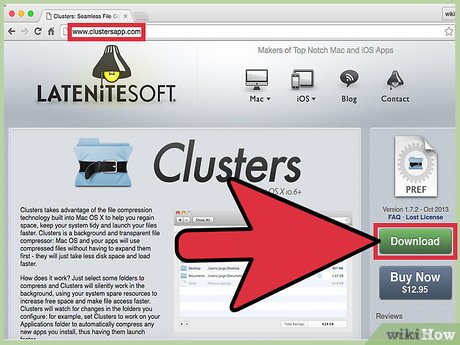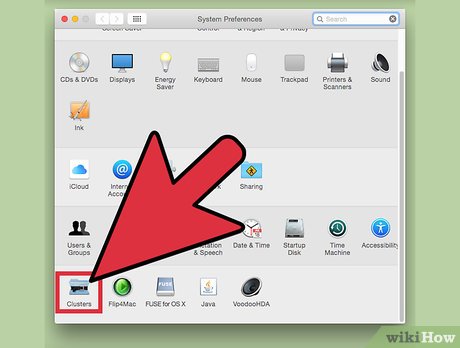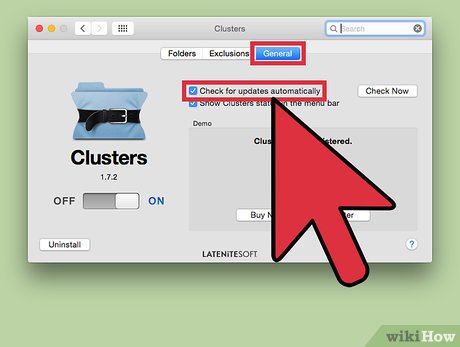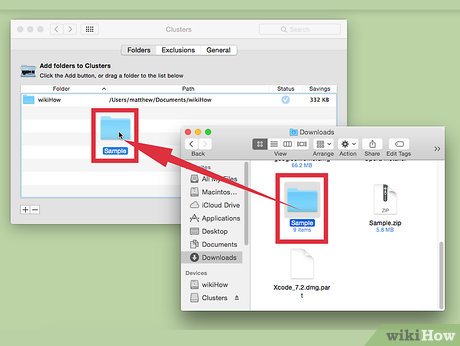How to Free Up Hard Disk Space on OS X with Squeeze
Part 1 of 2:
Getting Started
-
 Download and install the Squeeze program. Just go to www.clustersapp.com, and click on the green 'Download' button at the top of the page.
Download and install the Squeeze program. Just go to www.clustersapp.com, and click on the green 'Download' button at the top of the page.- Once you've downloaded and installed the program, you will quickly see that the Squeeze program is a preference panel, and not an application.
-
 Go to the 'System Preferences' section. The program will be in the 'Other' category.
Go to the 'System Preferences' section. The program will be in the 'Other' category. - View the available options at your disposal. Do so by going to the 'General' option. Below that, you will see an option that says 'Check for updates automatically.' Make sure it's checked.

Part 2 of 2:
Using and Optimizing Squeeze
-
 Locate the folders eating up space. To free up space on your hard drive, identify these space-munching folders.
Locate the folders eating up space. To free up space on your hard drive, identify these space-munching folders. -
 Control which folders you don't want to be compressed. If you're concerned that Squeeze might somehow alter your important files, you need not worry. Nevertheless, just place folders you don't want compressed in the 'Exclusions' tab.
Control which folders you don't want to be compressed. If you're concerned that Squeeze might somehow alter your important files, you need not worry. Nevertheless, just place folders you don't want compressed in the 'Exclusions' tab.- You can also add specific folders or set up file extensions that you don't want Squeeze to compress.
- By default, your entire Library, System folder(s), and a number of other extensions are excluded from being compressed by the Squeeze program.
-
 Drag a folder to the Squeeze list. This list is under the 'Folders' tab in the Squeeze window. Under the 'Status' tab, that tiny circle is an indicator of the compression progress of a folder. Once compression is completed, the circle transforms into a check mark.
Drag a folder to the Squeeze list. This list is under the 'Folders' tab in the Squeeze window. Under the 'Status' tab, that tiny circle is an indicator of the compression progress of a folder. Once compression is completed, the circle transforms into a check mark.- The number displayed on the far right of the screen indicates how much hard drive space has been freed up.
- Squeeze will keep on updating the list of folders it has compressed over time as well as the total hard drive space it has recovered.
-
 Drag another folder and repeat the process. You can drag as many folders as needed. Alternately, you can actually drag your entire hard drive, and place it in the program. That's another level of convenience put in place for you!
Drag another folder and repeat the process. You can drag as many folders as needed. Alternately, you can actually drag your entire hard drive, and place it in the program. That's another level of convenience put in place for you!
5 ★ | 1 Vote
You should read it
- Wipe the winSxS folder to free up windows space
- Use CMD to delete large folders on Windows
- How to Run a Program on Command Prompt
- Secure folders with Secure Folders software
- How to Create Folders in Mac
- Best application to help recover disk space
- Delete all empty folders on Android with just one touch
- Guide to lock, hide and secure files and folders with Hide Folders software
May be interested
- How to free up hard drive space with CompactGUI
 if you're running out of hard drive space and aren't willing to spend more to upgrade, data compression will be helpful in freeing up hard drive space and the best tool for this is compactgui.
if you're running out of hard drive space and aren't willing to spend more to upgrade, data compression will be helpful in freeing up hard drive space and the best tool for this is compactgui. - Disk Management access in Windows 7 and Windows 8
 this article shows you how to access and work with disk management for both windows 7 and windows 8. disk management is a powerful hard disk space management tool in windows. not only that, it also manages all other storage devices such as: floppy disks, flash disks ...
this article shows you how to access and work with disk management for both windows 7 and windows 8. disk management is a powerful hard disk space management tool in windows. not only that, it also manages all other storage devices such as: floppy disks, flash disks ... - 5 tips to free up hard drive space
 although there are more and more large hard drives, but no matter how big the drive is, you will find it missing one day.
although there are more and more large hard drives, but no matter how big the drive is, you will find it missing one day. - How to check and manage disk space in Linux
 a common problem is that updates fail due to a lack of disk space, but there are some simple tests that users can perform when they encounter an error message, to keep critical systems smooth operation.
a common problem is that updates fail due to a lack of disk space, but there are some simple tests that users can perform when they encounter an error message, to keep critical systems smooth operation. - Increase capacity and speed for hard drives
 do you need a certain amount of space on your hard drive? this is how we recommend it so you can free up to a few gb immediately.
do you need a certain amount of space on your hard drive? this is how we recommend it so you can free up to a few gb immediately. - 8 tricks to 'free' Mac drive
 for users of mac os x operating system, there are many issues to discuss and one of them is the issue of freeing memory capacity of the hard drive. in this article, we will introduce you to some of the simplest ways.
for users of mac os x operating system, there are many issues to discuss and one of them is the issue of freeing memory capacity of the hard drive. in this article, we will introduce you to some of the simplest ways. - Best application to help recover disk space
 spacesniffer has the ability to analyze hard drive and folder structure in an impressive and fast way that no other application can do the same.
spacesniffer has the ability to analyze hard drive and folder structure in an impressive and fast way that no other application can do the same. - What is a disk signature? Fix disk signature conflict error
 a disk signature is a unique, defined number of a hard drive or data storage device, stored as part of the master boot record (mbr).
a disk signature is a unique, defined number of a hard drive or data storage device, stored as part of the master boot record (mbr). - How to clean up junk files to reduce disk space C
 how to clean up junk files to reduce disk space c. after a long time using the computer, temporary files will generate junk files and take up hard disk space, sometimes they will make our computer work. no longer as smooth as before. we should correspond
how to clean up junk files to reduce disk space c. after a long time using the computer, temporary files will generate junk files and take up hard disk space, sometimes they will make our computer work. no longer as smooth as before. we should correspond - Hard Disk Sentinel - Download Hard Disk Sentinel here
 hard disk sentinel is an application designed to monitor hard drive activity and measure drive temperature, thereby helping users to prevent damage and data loss.
hard disk sentinel is an application designed to monitor hard drive activity and measure drive temperature, thereby helping users to prevent damage and data loss.











 How to Use Screen Sharing in OS X Leopard
How to Use Screen Sharing in OS X Leopard How to Make Phone Calls with Yosemite
How to Make Phone Calls with Yosemite How to Clear System Cache on PC or Mac
How to Clear System Cache on PC or Mac How to Avoid or Remove Mac Defender Malware from Mac OS X V10.6 or Earlier
How to Avoid or Remove Mac Defender Malware from Mac OS X V10.6 or Earlier How to Use SnapNDrag
How to Use SnapNDrag How to Use Spotlight to Search the Web
How to Use Spotlight to Search the Web